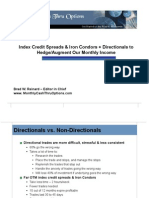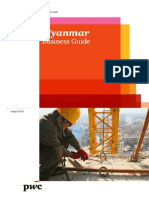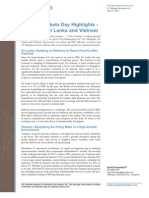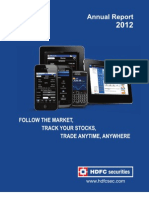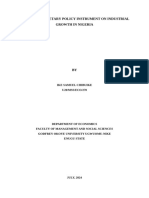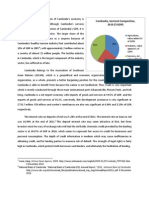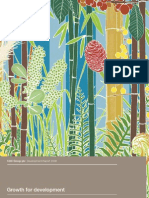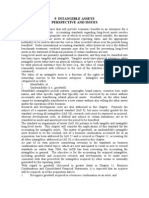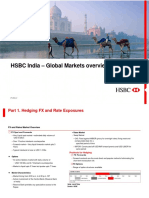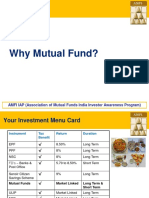Trend of Foreign Direct Investment, Net Inflows: Year Cambodia Bangladesh 2004 2005 2006 2007 2008 2009 2010 2011 2012
Trend of Foreign Direct Investment, Net Inflows: Year Cambodia Bangladesh 2004 2005 2006 2007 2008 2009 2010 2011 2012
Uploaded by
Didar RikhonCopyright:
Available Formats
Trend of Foreign Direct Investment, Net Inflows: Year Cambodia Bangladesh 2004 2005 2006 2007 2008 2009 2010 2011 2012
Trend of Foreign Direct Investment, Net Inflows: Year Cambodia Bangladesh 2004 2005 2006 2007 2008 2009 2010 2011 2012
Uploaded by
Didar RikhonOriginal Description:
Original Title
Copyright
Available Formats
Share this document
Did you find this document useful?
Is this content inappropriate?
Copyright:
Available Formats
Trend of Foreign Direct Investment, Net Inflows: Year Cambodia Bangladesh 2004 2005 2006 2007 2008 2009 2010 2011 2012
Trend of Foreign Direct Investment, Net Inflows: Year Cambodia Bangladesh 2004 2005 2006 2007 2008 2009 2010 2011 2012
Uploaded by
Didar RikhonCopyright:
Available Formats
Trend of Foreign Direct Investment, Net Inflows
This series shows Net Inflows (new investment inflows less disinvestment) in an economy from foreign investors. Data are in U.S. dollars. The latest value for Net Inflows in Cambodia was USD 1,557,134,885 as of 2012. Over the past 9 years, the value for this indicator has fluctuated between USD 131,416,229 in 2004 and USD 1,557,134,885 in 2012. On the other hand, the latest value for Net Inflows in Bangladesh was USD 1,178,439,622 as of 2012. Over the past 9 years, the value for this indicator has fluctuated between USD 448,905,401 in 2004 and USD 1,178,439,622 in 2012. Source: http://data.worldbank.org/indicator/BX.KLT.DINV.CD.WD?display=default Year 2004 2005 2006 2007 2008 2009 2010 2011 2012 Cambodia 131,416,229 379,180,191 483,209,383 867,288,539 815,180,218 539,113,440 782,596,735 901,668,591 1,557,134,885 Bangladesh 448,905,401 813,321,972 697,206,284 652,818,719 1,009,623,164 732,809,636 918,172,638 1,137,916,361 1,178,439,622
A graphical comparison of Foreign Direct Investment, Net Inflows of these two countries is shown below
1,800,000,000 1,600,000,000 1,400,000,000 1,200,000,000 1,000,000,000 800,000,000 600,000,000 400,000,000 200,000,000 0 2004 2005 2006 2007 2008 2009 2010 2011 2012 Cambodia Bangladesh
Factors that Attract Cambodia as Best FDI Destination
Amidst global economic frailty, Foreign Direct Investment in Cambodia grew by an impressive 67% in 2012. The FDI reached USD1.6 billion in 2012, compared to USD 902 million in 2011. There are investment opportunities in the following sectors in Cambodia Agriculture and Agro Industry Transportation and Telecommunication Sector Energy Sector Labor Intensive Industries and Export Oriented Industries Processing Industry Tourism Sector Human Resource Development Oil & Gas, Mining
The influx in investment is credited to the following factors Safe Banking Sector
One of the authorities playing a key role in Cambodia's macro-economic success is the National Bank of Cambodia (NBC) which has overseen trade policies, market liberalization and low inflation that has defined the country's economic development. As the country's central bank and highest financial regulatory body, NBC determines the monetary and exchange policies within the framework of the economy and supervises the fast-growing banking sector and financial services industry. Among the notable achievements are the total banking sector assets reaching 80 percent of GDP in 2012 versus just 22 percent in 2005. Over the same nine year period, credits and deposits surged to 43 percent and 46 percent of GDP, respectively, from 09 percent and 15 percent. Cambodias strength in Greenfield projects in retail banking. Over the past decade, Cambodias banking sector attracted the most capital, US$2.3 billion, of any least developed country, and the second highest number of projects, at 56. Strong Bilateral Relations
Economic diversification is attracting substantial sums of FDI from China and beyond. Home to the fastest-growing economy in Southeast Asia, Cambodia enjoys excellent bilateral political and fiscal ties to the People's Republic of China that continue to strengthen after being formed 55 years ago. The NBC recently signed a Memorandum of Understanding (MOU) with the China Banking Regulatory Commission. Chea Chanto. The MOU will create an exchange of information and cooperation in banking supervision both inside and outside of the country. As a result, the Chinese authorities will be able to inspect and supervise branch activities while at the same time to help to improve the knowledge and skills of local workers. The State-owned authority recently opened a $28 million container terminal financed by a loan from the Chinese government. Small Businesses Serve as Backbone of Sustainable Economy
Historically, Cambodia has relied on the role of small- and medium-sized enterprises (SMEs) as the backbone of a sustainable economy. Generally, in Cambodia when we talk about SME economic activities, we are in fact talking about micro-small and medium-sized enterprises (MSMEs), as out of the more than 500,000 economic establishments or enterprises counted in the 2011 Cambodia Economic Census, some 493,000 of them employ only one to 10 employees. Growth in the number of MSMEs could help expand the economy, create more jobs, facilitate Foreign Direct Investment, and enlarge the tax collection base. The 2011 census shows that more than 500,000 economic establishments
were engaged in economic activities, employing more than 1.6 million laborers or approximately 20 percent of the total Cambodian labor force.
Strategic Position
Home to the fastest-growing economy in Southeast Asia, Cambodia enjoys a strategic position. Established in 1986, Phnom Penh Autonomous Port is the country's second largest international port and boasts a strategic position at the intersection of four major rivers in the heart of the country. Business Climate
Rich in history and culture and blessed with wonderful natural and human resources that are driving its impressive economic growth and attracting record sums of foreign direct investment (FDI), the Kingdom of Cambodia offers investors a modern, friendly and welcoming business climate. Investment Protection
The Investment Law and Sub-decree of Cambodia contain a number of important guarantees for the investors: Equal treatment of all investors No requirement of local equity participation No price controls on products or services No restriction on ForEx convertibility Free remittance of foreign currencies abroad
There are several investment incentives such as 20% Corporate Tax Tax holidays of 3 years Full Import Duty Exemption Repatriation of profit (withholding tax) Reinvestment of earning (special depreciation) Labor Intensive Economy
Many major international companies have invested hundreds of millions of dollars in laborintensive garment and manufacturing industries to take advantage of the country's young population and duty free access to a number of lucrative markets such as the EU.
Businesses are looking to cut costs in labor intensive industries, particularly the garment sector. Cambodia is touted as a bright spot in Southeast Asia, where overall FDI increased by only 2%. Special Economic Zones (SEZs)
Cham Prasidh, senior minister and minister of Commerce, has played a key role in Cambodias emergence as leading FDI destination and in the creation of more than 20 strategically-located Special Economic Zones (SEZs) around the country which ensure better infrastructure and One Stop Services/SEZ Zone Administration, including SEZs near the borders with Thailand and Vietnam. 22 SEZs have been authorized and are being developed by private investors/operators. Five SEZs are currently in operation, the remainders are in various stages of development. Pro-business Government:
The government has committed to a Pro-business/Investor Model which resulted in the formation of Government-Private Sector Forum (GPSF) which includes the followings o o o o Steering Committee for the Private Sector Development: Sub-steering committee on Investment Climate Sub-steering committee on Trade Facilitation Sub-steering committee on SME Development
There are 9 Working Groups chaired by Government and Private Sectors representative who meet on a monthly basis to address the issues relating to doing business and investment in Cambodia. GPSF conducted in every six months, presided over by Prime Minister to ensure o Easy access to Government Officials o Prompt response to all inquiries
Challenges
Corruption Although the businesses in Cambodia are optimistic of the countrys economy, its appeal as an investment destination lags behind most of its neighbors due to the perception of endemic corruption. There are several benefits of doing business in Cambodia as mentioned above. For companies already operating in Cambodia, the profit outlook was overwhelmingly positive.
Yet foreign companies not based in the country were less excited about making the move to Cambodia, which placed 8th out of the 10 ASEAN countries, behind Laos and Brunei. Reasons cited by companies were a shortage of skilled workers, unfavorable laws and regulations and underdeveloped infrastructure .But the major worry for most of the investors is corruption. Accuracy of the Statistics
For the first time in recent memory, the Ministry of Economy and Finance has released growth projections for the first half of the year, and the numbers are good. The ministrys preliminary data claims that from January through June, economic growth stood at 7.6 percent, an announcement that critics are questioning not only for accuracy but also for timing. Risk of Credit Growth
The World Bank has warned that the rapid growth of lending by Cambodias Banks is still a concern, despite a recent slow-down in credit disbursals. Credit growth, which has been driven largely by wholesale and retail financing, and starting in 2011 agriculture financing, has eased to 29.2 percent (year on year) in January 2013. The annualized rate of lending growth was 34 percent in December and as high as 34.6 percent in January 2012. Limited Access to Capital
Commercial banks are a primary source of funding. Limited access to capital is one of the constraints of doing business in Cambodia. In 2011, the key players in Cambodias financial sector are 31 Commercial banks, 2 Representative Offices, 7 specialized banks and 32 microfinance institutions, 28 micro-finance NGOs and 11 insurance companies. The top-4 hold over 70% of total deposits and loans in the banking system. Ownership and Use of Land
The Law on Investment of Cambodia restricts foreigners from owning land in Cambodia since land ownership is reserved to natural and legal Cambodians. Employment of Foreigners
A business is entitled to obtain visas and work permits for the employment in Cambodia of foreign citizens as managers, technicians and skilled workers, if the qualification and expertise are not available in Cambodia.
You might also like
- Jun18l1pma-C02 QaDocument4 pagesJun18l1pma-C02 Qarafav10No ratings yet
- ForexHack PDFDocument6 pagesForexHack PDFNugraha MuktiNo ratings yet
- Dan Sheridan: RulesDocument54 pagesDan Sheridan: RulesOptionPoncho100% (2)
- Myanmar Business GuideDocument40 pagesMyanmar Business GuideAlessandra ValentiNo ratings yet
- Myanmar Business GuideDocument40 pagesMyanmar Business GuideKo Nge100% (2)
- Macro (FDI)Document21 pagesMacro (FDI)Nina RichieNo ratings yet
- Practical Orientation: of National Bank LimitedDocument10 pagesPractical Orientation: of National Bank LimitedJamal Uddin RajibNo ratings yet
- Where To Enter Location: 24. PailinDocument7 pagesWhere To Enter Location: 24. PailinMarshiela MahzairNo ratings yet
- International Marketing ComparisonDocument8 pagesInternational Marketing ComparisonNapa ChuenjaiNo ratings yet
- Prime MinisterDocument3 pagesPrime MinisterVanthan KimNo ratings yet
- Prasarn Trairatvorakul: The Strength of The Thai Economy and Future Development in Thailand's Financial SystemDocument3 pagesPrasarn Trairatvorakul: The Strength of The Thai Economy and Future Development in Thailand's Financial Systemivan anonuevoNo ratings yet
- Case Study On NDB and DFCCDocument34 pagesCase Study On NDB and DFCCRantharu AttanayakeNo ratings yet
- AssignmentDocument13 pagesAssignmentAtiqul Islam33% (3)
- Nurfatin Najiha Fazal MohamedDocument9 pagesNurfatin Najiha Fazal MohamedFatin Najiha FazalNo ratings yet
- Business Model: A Strategic Business Approach, Case of Bank BJBDocument39 pagesBusiness Model: A Strategic Business Approach, Case of Bank BJBFezi Afesina HaidirNo ratings yet
- VietinBank EngDocument152 pagesVietinBank EngMonkey2111No ratings yet
- Cambodia Lacks Skilled WorkforceDocument3 pagesCambodia Lacks Skilled WorkforceChou ChantraNo ratings yet
- Cambodia Country Business Profile 2009Document4 pagesCambodia Country Business Profile 2009pnhvnNo ratings yet
- Omon ArticleDocument19 pagesOmon ArticleAigbokhaoode MathiasNo ratings yet
- Contribution of Financial Market in BDDocument8 pagesContribution of Financial Market in BDAmeen IslamNo ratings yet
- TCQTDocument3 pagesTCQTLý ThụcNo ratings yet
- Frontier Markets HighlightsDocument4 pagesFrontier Markets HighlightsVivian HoNo ratings yet
- Investment BankingDocument6 pagesInvestment BankingZubariaAslamNo ratings yet
- Indian Economic Survey 2012Document10 pagesIndian Economic Survey 2012Krunal KeniaNo ratings yet
- HDFC Securities Annual Report 11-12 FinalDocument35 pagesHDFC Securities Annual Report 11-12 Finaljohn_muellorNo ratings yet
- 16-219-237 A Study On The Effects of FDI On Cambodia's Economic Growth by HUON Sophanara-FinalDocument19 pages16-219-237 A Study On The Effects of FDI On Cambodia's Economic Growth by HUON Sophanara-Finalphang brostouchNo ratings yet
- Bangladesh Quarterly Economic Update - March 2012Document28 pagesBangladesh Quarterly Economic Update - March 2012Asian Development BankNo ratings yet
- Full AssignmentDocument37 pagesFull AssignmentMd Sifat Khan83% (6)
- Niveshak Niveshak: AuditorsDocument26 pagesNiveshak Niveshak: AuditorsNiveshak - The InvestorNo ratings yet
- Cau Hoi CKDocument15 pagesCau Hoi CKdoanthunguyet.pisaNo ratings yet
- Asia SME Finance Monitor 2014 PDFDocument9 pagesAsia SME Finance Monitor 2014 PDFSan SéngNo ratings yet
- Cashless Policy (2011)Document8 pagesCashless Policy (2011)Nwigwe Promise ChukwuebukaNo ratings yet
- Doing Business in ChinaDocument26 pagesDoing Business in ChinaShariq KhanNo ratings yet
- Prospects and Problems of FDI in Bangladesh Prospects of FDIDocument2 pagesProspects and Problems of FDI in Bangladesh Prospects of FDIMEHTA BINTE MASUDNo ratings yet
- FIP Assignment # 2Document11 pagesFIP Assignment # 2talhashafqaatNo ratings yet
- FDI Inflows in BD - Problems & ProspectsDocument26 pagesFDI Inflows in BD - Problems & ProspectsAvijit Bhowmick Avi100% (2)
- Olutunla and ObamuyiDocument6 pagesOlutunla and ObamuyiDithaDestiahNo ratings yet
- The Impact of Private Sector Credit On Economic Growtth in NigeriaDocument22 pagesThe Impact of Private Sector Credit On Economic Growtth in NigeriaMbongeni ShongweNo ratings yet
- Comparative Analysis of MSME Financial Institutions in Select CountriesDocument75 pagesComparative Analysis of MSME Financial Institutions in Select CountriesGogol SarinNo ratings yet
- Performance and Obstacles of SMEs in Viet NamDocument26 pagesPerformance and Obstacles of SMEs in Viet NamSơn Huy CaoNo ratings yet
- Electronica Finance Limited: Designing The Future of Micro, Small, and Medium EnterprisesDocument11 pagesElectronica Finance Limited: Designing The Future of Micro, Small, and Medium EnterprisesSamadarshi SiddharthaNo ratings yet
- Cambodia Doing Business 2011Document66 pagesCambodia Doing Business 2011Ed Sawyer100% (1)
- Banking Sector in CambodiaDocument9 pagesBanking Sector in Cambodiaសួន សុខាNo ratings yet
- Factors Affecting The Net Interest Margin of Commercial Bank of EthiopiaDocument12 pagesFactors Affecting The Net Interest Margin of Commercial Bank of EthiopiaJASH MATHEWNo ratings yet
- MasumDocument16 pagesMasumOnnya ChowdhuryNo ratings yet
- New Microsoft Word DocumentDocument5 pagesNew Microsoft Word DocumentKamrul HasanNo ratings yet
- Samuel CDocument31 pagesSamuel Cikesamuel24No ratings yet
- I JB Mer 2015060103Document9 pagesI JB Mer 2015060103ahmedNo ratings yet
- BangladeshDocument3 pagesBangladeshsrishtikharb2579No ratings yet
- Lao GDP Update April2007Document2 pagesLao GDP Update April2007api-3745429100% (1)
- Foreign Direct Investment Scenario Bangladesh Perspective - 93287Document17 pagesForeign Direct Investment Scenario Bangladesh Perspective - 93287rashed_8929685No ratings yet
- Economic Zones As Key Players in Economic Advancement: The Bangladesh PerspectiveDocument16 pagesEconomic Zones As Key Players in Economic Advancement: The Bangladesh PerspectiveJames XgunNo ratings yet
- FOCUSC FDI and Foreign Loan, DebtDocument8 pagesFOCUSC FDI and Foreign Loan, DebtMD Ashraful IslamNo ratings yet
- Mar 282012 GseDocument4 pagesMar 282012 GseAhmed NirobNo ratings yet
- Cambodia Sectoral CompositionDocument4 pagesCambodia Sectoral Compositionliv_kimNo ratings yet
- Development Report FINAL 2009Document100 pagesDevelopment Report FINAL 2009Richard ReesNo ratings yet
- SME Catalyst For GrowthDocument8 pagesSME Catalyst For GrowthrobinjoburgNo ratings yet
- Group 24Document23 pagesGroup 24dineomokoena327No ratings yet
- Outlook For Banks 2010Document6 pagesOutlook For Banks 2010khabis007No ratings yet
- Origin of The Report: Hapter NtroductionDocument26 pagesOrigin of The Report: Hapter NtroductiondarkniightNo ratings yet
- Banking in Africa: financing transformation amid uncertaintyFrom EverandBanking in Africa: financing transformation amid uncertaintyNo ratings yet
- 9 Intangible Assets AccountingDocument25 pages9 Intangible Assets Accountingredearth2929No ratings yet
- ValuationDocument11 pagesValuationDidar RikhonNo ratings yet
- Acronyms and Abbreviations: Assignment OnDocument3 pagesAcronyms and Abbreviations: Assignment OnDidar RikhonNo ratings yet
- A Study of Financial Policies and Procedures of Suvastu Development LTD - (A Study On Gulshan Branch)Document23 pagesA Study of Financial Policies and Procedures of Suvastu Development LTD - (A Study On Gulshan Branch)Didar RikhonNo ratings yet
- Do Mutual Funds Time The Market? Evidence From Portfolio HoldingsDocument49 pagesDo Mutual Funds Time The Market? Evidence From Portfolio HoldingsDidar RikhonNo ratings yet
- Performance Evaluation of ICB Mutual FundsDocument61 pagesPerformance Evaluation of ICB Mutual FundsDidar Rikhon100% (1)
- The Market Efficiency Hypothesis (MEH)Document30 pagesThe Market Efficiency Hypothesis (MEH)Priyanka RaipancholiaNo ratings yet
- PDFDocument6 pagesPDFshrushtiNo ratings yet
- Expected Returns For Private EquityDocument23 pagesExpected Returns For Private Equity10yangb92No ratings yet
- Inflation Curve Construction OpenGammaDocument16 pagesInflation Curve Construction OpenGammasoumensahilNo ratings yet
- Jan 192014 Dos 01 eDocument11 pagesJan 192014 Dos 01 erakhalbanglaNo ratings yet
- Determination of Forward and Futures PricesDocument26 pagesDetermination of Forward and Futures PricesHarshvardhan MohataNo ratings yet
- Analysts Malaysia's IPO Boom Is A One-OffDocument2 pagesAnalysts Malaysia's IPO Boom Is A One-OffLauHuiPingNo ratings yet
- MFATADocument7 pagesMFATARODRIGO TROCONISNo ratings yet
- April 2011: NSDL - Trusted by More Than One Crore Account HoldersDocument8 pagesApril 2011: NSDL - Trusted by More Than One Crore Account HoldersimpworkinprogressNo ratings yet
- Kores India LTD 2010Document10 pagesKores India LTD 2010Sriram RanganathanNo ratings yet
- A Guide To RBIs Weekly Statistical Supplement - Part IIDocument11 pagesA Guide To RBIs Weekly Statistical Supplement - Part IIparthasarathi_inNo ratings yet
- MessagingDocument9 pagesMessagingHEMANT SARVANKARNo ratings yet
- SRC Rule 68, As Amended Rules and Regulations Covering Form and Content of Financial StatementsDocument18 pagesSRC Rule 68, As Amended Rules and Regulations Covering Form and Content of Financial StatementsClifford ParishNo ratings yet
- IDFC Infrastructure FundDocument70 pagesIDFC Infrastructure FundPriya NarsinghaniNo ratings yet
- CAPMDocument77 pagesCAPMaon aliNo ratings yet
- NBP RateSheet 28 06 2019Document1 pageNBP RateSheet 28 06 2019Tahseen AhmedNo ratings yet
- HSBC India Global Markets OverviewDocument10 pagesHSBC India Global Markets OverviewKaustubh KambekarNo ratings yet
- Forex ManualDocument100 pagesForex Manualcastroyal100% (2)
- Investment Securities Classification On Balance SheetDocument2 pagesInvestment Securities Classification On Balance Sheetfawad101No ratings yet
- Buletin BVB OCT2018Document61 pagesBuletin BVB OCT2018Bogdan Marian CroitorNo ratings yet
- Samala Vs PalanaDocument5 pagesSamala Vs PalanaJhoy CorpuzNo ratings yet
- Why Mutual Fund?: AMFI IAP (Association of Mutual Funds India Investor Awareness Program)Document30 pagesWhy Mutual Fund?: AMFI IAP (Association of Mutual Funds India Investor Awareness Program)swapnil deokarNo ratings yet
- Accounting Case StudyDocument14 pagesAccounting Case StudyRenz PamintuanNo ratings yet
- SALES Midterm Reviewer Art 1458-1502Document28 pagesSALES Midterm Reviewer Art 1458-1502Justine Dawn Garcia Santos-Timpac100% (2)
- 324 - Foreign Exchange Market-ForEXDocument74 pages324 - Foreign Exchange Market-ForEXTamuna BibiluriNo ratings yet
- GAIL Vijaipur (MP PL) (May 24) Salary SlipDocument41 pagesGAIL Vijaipur (MP PL) (May 24) Salary Slipuanubhav289No ratings yet
- Foreign Exchange and Foreign Currency Options Conventions PDFDocument18 pagesForeign Exchange and Foreign Currency Options Conventions PDFShivramakrishnan IyerNo ratings yet


